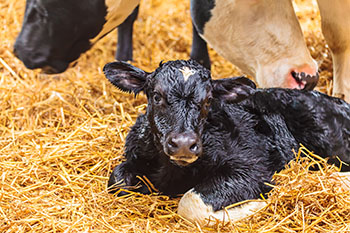5 Strategies to Implement for a Successful Calving Season
Feb 02, 2020

While spring may seem far away, beef producers should be preparing for the upcoming calving season. In Wisconsin, when cows are in late gestation during winter, this can result in nutrient demand being some of the greatest of the entire year. Additionally, we have had some challenging winter weather the past few years, and the spring has come in like a lion. What are some strategies to implement now to be better prepared for this year’s calving season?
1. Body condition score your cow herd.
Body condition score a measure of the nutritional status of the herd. Our target is to have beef cows at body condition score 6 at calving. If the herd is not meeting this target, design a supplementation plan to reach this goal. Also, very important to not short the cow’s nutrition in late gestation, the calf is demanding energy the last month of gestation and will be growing at a rate of 1 lb/d. When temperatures enter the single digits and below zero for more than 2-3 days, then need to consider how to add more energy to the diet. Being prepared for this type of weather can help make sure you keep cows in good condition and don’t have weak calves.
2. Provide a well-balanced mineral.
Cows supplemented with high-quality mineral at least 60 days before calving produce better colostrum, leading to increased passive immunity in the calf. In return, calves perform better, have fewer incidences of scours, and decreased treatment rates, which resulted in heavier weaning weights. Also, mineral nutrition during gestation provides the framework for the calf’s trace mineral stores. Once the calf is born, it will rely predominately on these stores to help develop the immune system as well as be the primary mineral source to calf until weaning.
3. Provide supplemental nutrition to calves when needed.
Even in well-managed herds, you can encounter times when a calf may need supplemental nutrition. As soon as possible, provide Land O Lakes® Bovine IgG Colostrum replacement to calves that may have not suckled or to calves from first-calf heifers. Also, providing the calf with Land O Lakes® Calf Insure®, can be beneficial for additional gut health and digestive system support. For calves experiencing dehydration due to cold stress or other environmental factors, provide Land O Lakes® Electrolyte System® or Electrolyte Complete® products.
4. Develop a health plan with your local veterinarian.
Sit down and review your vaccination protocols and treatment protocols for issues such as scours or other health challenges with your veterinarian. Important to take a preventative health approach for calving but also being prepared to respond quickly when health challenges arise may help reduce the impact of health challenges.
5. Prepare a clean, dry environment for cows and calves.
Reducing the amount of pathogens calves are exposed to at calving will help reduce the risk of health issues. First, calve in an area that cows were not housed in all winter, if possible. While cows may not need bedding most, once you start calving have a clean, dry place to lay down will keep the udder clean and reduce stress on cows. Also, providing creep areas for calves can be beneficial. Feeding Rumensin® prior to calving can also help prevent and control the shedding of coccidiosis, one possible cause of scours.
Benjamin Franklin said it well, “an ounce of prevention is worth a pound of cure.” Taking steps now to assess your cows and review plans are critical steps to achieving the goal of a prosperous calving season. Reach out to your Premier nutritionist to determine supplementation needs and review your mineral needs.
Dr. Amy E. Radunz | Beef Technical Consultant - Purina Animal Nutrition
